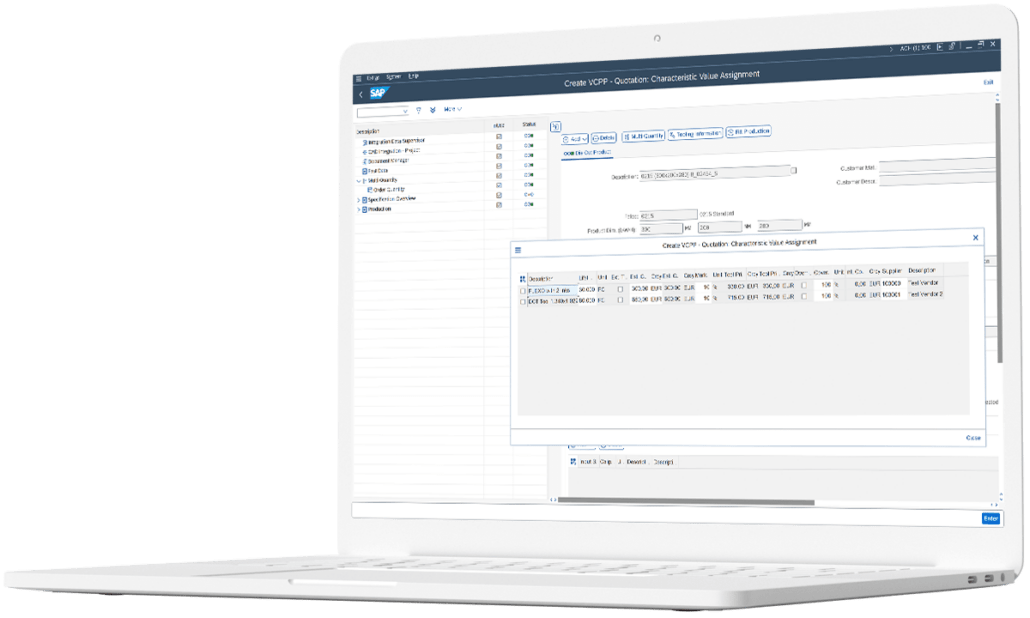Expandable process alleviating all tooling management related SAP processes in your ERP system
The Tooling Manager utilizes SAP standard processes for material movements, ensuring standardized cross-plant tracing for improved efficiency and accountability. This means that the system helps track and manage tools across different locations, making the process more efficient and accountable. With the usage of a tool set for print designes it is possible to order and re-order multiple ink tools collectively, before creating individual batches for efficient traceabilty.

PRECISION IN PROGRESS
The process of inputting tool data into the system and creating comprehensive master data.
Identifying tool availability, assessing tool condition for any damage, and determining the remaining lifespan of tools.
Optimize order management by scheduling effectively, allocating resources efficiently, and prioritizing orders based on urgency, customer needs, and production capacity.
Over the entire lifespan of a tool, there comes a point where repairs or modifications may be necessary to accommodate any changes.
Simplify the entire process when receiving the tool from the supplier to perform an initial inspection and complete all necessary tasks.
Persona-based design plays a crucial role in enabling seamless system operation, minimizing the need for recurring training, and promoting the integration of tools and processes through user-friendly interfaces and continuous learning.
Ensuring Precision in Information Exchange
Individuals responsible for acquiring tools ensure that suppliers receive accurate information and data pertaining to the tools being purchased, facilitating smooth transactions.
Staff managing the tool preparation supervise the receipt, inspection, validation, and release of tools from suppliers, ensuring they are ready for production and meet quality standards.
The design department handles requests for minor adjustments, such as positioning changes, ensuring seamless triggering of modifications to enhance efficiency.
Customer service teams play a crucial role in evaluating price changes communicated by suppliers, ensuring that customers are promptly informed of any arrangements made.
TOOLING MANAGER
From the initial quotation phase to the creation of tool master data, our comprehensive approach covers defining tool specifications, capturing data seamlessly alongside finished goods, and utilizing batch management for insightful live updates, ensuring efficient and informed decision-making throughout the entire tooling lifecycle.
Initiation begins with the quotation phase, during which the intended purpose of the project is defined, encompassing processes like die-cutting and printing. This phase involves determining tool costs, assessing the anticipated lifespan of tools, and identifying potential sources. Data is systematically captured, including tool information and finished goods material, providing a centralized storage for future master data creation. Master data creation facilitates the creation of finished goods, also procurement materials, and tools if needed. The generation of tool master data results in a document information record that serves as an extension for print design. This record includes details on the number of colors available and specifies the tools compatible with each ink.
Various elements can be specified or are set by default, including tool lifespan, supplier, tool expenses, and customer cost coverage. The tool lifespan indicates the expected duration of the tool, aiding in planning maintenance schedules and replacement timelines. Early estimation of tool costs facilitates budgeting and cost projection for the project or production process. Determining the tool price, taking into account factors like markup percentage, ensures competitive pricing while generating sufficient revenue. Allocating costs between customers and internal operations involves deciding how tool-related expenses will be distributed, ensuring fair and transparent pricing for customers and effective coverage of internal expenses. In the reordering process, each tool manager oversees multiple physical tools, ensuring standardized cross-plant tracing for improved efficiency and accountability. This means the system assists in tracking and managing tools across different locations, enhancing the overall efficiency and accountability of the process.
Batch-managed tools simplify the storage of initial information in the material master by connecting it to the physical tool through batch classification. When a tool is used in a production order, the batch classification is updated to show how often the tool is used. The system is designed to handle configured tools, using existing information when creating a new batch. In the reordering process, multiple physical tools are managed per tool manager, ensuring standardized cross-plant tracing for improved efficiency and accountability. This means that the system helps track and manage tools across different locations, making the process more efficient and accountable.